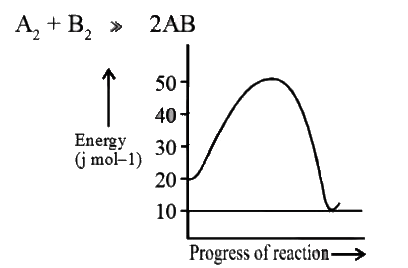Calculate resonance energy of C6H6(g).
Given :Δf[C6H6(g)]=−360kJmol−1ΔHSub[C(graphite)]=716kJmol−1B.E.H−H=437kJmol−1B.E.C=C=620kJmol−1B.E.C−C=340kJmol−1B.E.C−H=490kJmol−1
For C6H6
6C(s)+3H2(g)→C6H6,ΔHexp=−360 kJ mol−1
∴ΔHcal =−[3(C−C)+3(C=C)+6(C−H)]+[6CS→g+3(H−H)]
=−[3×340+3×620+6×490]+[6×716+3×437]
=−5820+5607=−213 kJ mol−1
∴ Resonance energy =Exp. ΔHf− calculated ΔHf
=−360−(−213)=−360+213=−147 kJ mol−1
Topper's Solved these Questions
- BOOK - BANSALCHAPTER - THERMOCHEMISTRYEXERCISE - SOLVED EXAMPLE32videos
THERMOCHEMISTRY
- BOOK - BANSALCHAPTER - THERMOCHEMISTRYEXERCISE - Exercise8videos
THERMOCHEMISTRY
- BOOK - BANSALCHAPTER - TEST PAPERSEXERCISE - PHYSICS1videos
TEST PAPERS
- BOOK - BANSALCHAPTER - THERMODYNAMICSEXERCISE - Exercise 343videos
THERMODYNAMICS
Similar Questions
Calculate ΔH∘f of C6(s) from the following data:,
ΔHcomb of C6H12O6(s)=−2816kJ mol−1,ΔH∘f of CO2(g)=−393.5kJ mol−1andΔH∘f(H2O)=−285.9kJ mol−1.View SolutionCalculate the resonance energy of gaseous benzene form the following data.
BE(C−H)=416.3kJmol−1
BE(C−C)=331.4kJmol−1
BE(C=C)=591.1kJmol−1
ΔsubHΘ(C,graphite)=718.4kJmol−1
ΔdissHΘ(H2,g)=435.9kJmol−1
ΔfHΘ(benzene,g)=82.9kJmol−1View Solution
Knowledge Check
- Question 1 - Select One
Calculate resonance enthalpy of CO2(g) from following data:
ΔH∘combustion[Cgraphite]=−390Kj/mol
ΔH∘Sublimation[Cgraphite]=−715Kj/mol
ΔHB.E.[O=O]=500KJ/mol
ΔHB.E.[C=O]=875KJ/molA−40KJ/molB−145KJ/molC−72.5KJ/molD−290KJmol
Calculate the enthalpy change for the process
CCl4(g)→C(g)+4Cl(g)
and calculate bond enthalpy of C−Cl in CCl4(g).
ΔvapHΘ(CCl4)=30.5kJmol−1
ΔfHΘ(CCl4)=−135.5kJmol−1
ΔaHΘ(C)=715.0kJmol−1, where ΔaHΘ is enthalpy of atomisation
ΔaHΘ(Cl2)=242kJmol−1View SolutionConsider the following energy diagram for the reaction.
A2+B2?2AB

Column IColumn II(A)Ea(f)(P)−10 kJ mol−1(B)Ea(b)(Q)40 kJ mol−1(C)ΔHr(R)30 kJ mol−1(D)ET(S)50 kJ mol−1View SolutionCalculate the enthalpy of hydrogenation ofC2H2(g) to C2H4(g).
( Given bond energies: C−H=414.0kJmol−1,
C≡C=827.6kJmol−1,
C=C=606.0kJmol−1,
H−H=430.5kJmol−1)View SolutionCalculate the enthalpy change during the reaction :
H2(g)+Br2(g)→2HBr(g)
Given, eH−H=435kJmol−1,eBr−Br=192kJmol−1 and eH−Br=368kJmol−1.View SolutionCalculate the enthalpy change for the process
CCl4(g)→C(g)+4Cl(g)
and calculate bond enthalpy of C−Cl in CCl4(g).
ΔvapHΘ(CCl4)=30.5kJmol−1
ΔfHΘ(CCl4)=−135.5kJmol−1
ΔaHΘ(C)=715.0kJmol−1, where ΔaHΘ is enthalpy of atomisation
ΔaHΘ(Cl2)=242kJmol−1View SolutionCalculate Kp for the reaction
C2H4(g)+H2(g)⇔C2H6(g)
ΔG∘=−100kJmol−1 at 25∘CView SolutionCalculate the lattice energy of the reaction
Li⊕(g)+CIΘ(g)→LiCI(s)
from the following data:
ΔsubHΘ(Li)=160.67kJmol−1,12D(CI2)=122.17kJmol−1IP(Li)=520.07kJmol−1,EA(CI)=−365.26kJmol−1 and ΔfHΘ(LiCI)=−401.66kJmol−1View Solution

